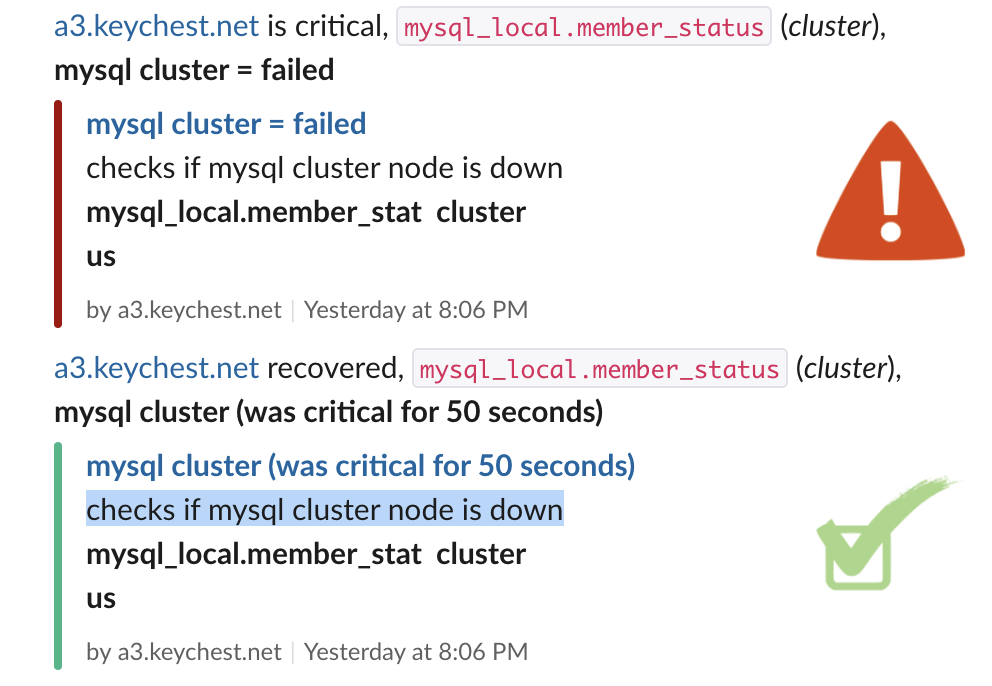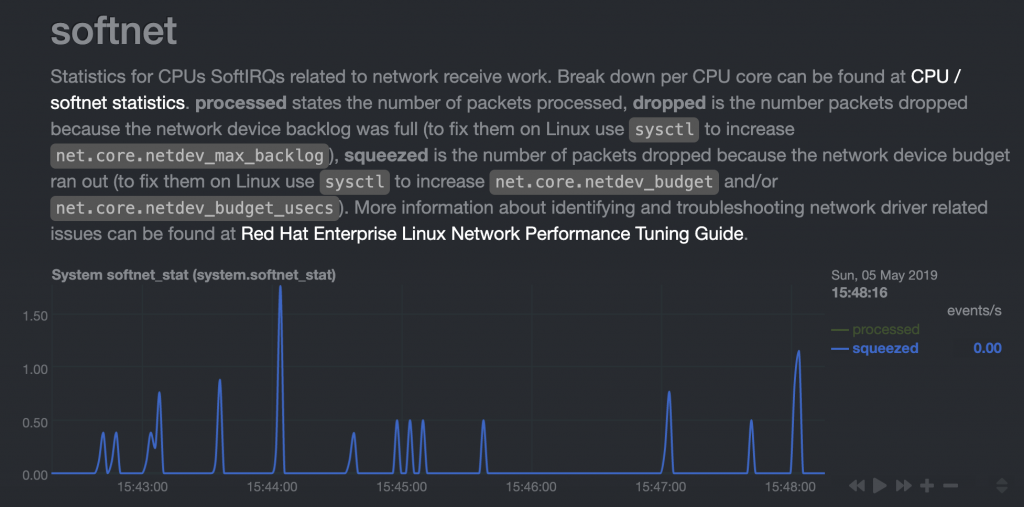This is my second post on the topic of reliable MySQL8 cluster. Hopefully the last one as things look much brighter now.

I have been yet again forced to look even deeper than last time into the underlying issues causing KeyChest crashes. The logs showed that cluster nodes kept losing connection with other nodes and were “kicked out”.
Search For The Cause
I could focus the search for the cause of MySQL cluster instability thanks to Netdata. This monitoring system has been constantly showing a large percentage of dropped packets on a public interface of one of the cluster nodes. I didn’t think too much about it at first as the warning was for a public network interface, which was not used by KeyChest. As such, I assumed the problem could simply be linked to the firewall.
This time, I took the issue more seriously and used a couple of tools (well, I tried most of the diagnostics from this comprehensive tutorial (tuning Linux networking stack) – available for Centos7. Netstat showed dropped RX packets – interestingly on public as well as private NICs.
Iface MTU RX-OK RX-ERR RX-DRP RX-OVR TX-OK ...
eth0 1500 95892 0 3825 0 80290
eth1 1500 24108079 0 3825 0 23952080
lo 65536 22389898 0 0 0 22389898
Another glance at netstat data showed a pretty high softirq number and when I zoomed on squeezed out packets, it showed continuously non-zero values.

Software interrupts (softirqs) was another symptom that didn’t disappear even when I increased the default value of net.core.netdev_budget with sysctl. I have also used the perf tool and sent stack locations where packets were lost to the DigitalOcean support as they meant very little to me.
To cut the story short, I had to accept that there is nothing I can do with the networking issues and there are likely to be significant “bursts” of dropped packets that will cause disconnection of our MySQL8 cluster nodes.
So we know there is very likely an infrastructure problem. The question is, can we mitigate it on the application layer?
MySQL Tuning
The first thing was to adjust sysctl values related to networking – as the MySQL cluster is fairly utilised, with a limit of 500 connections, it was worth reviewing file handle and network-related values – net.core.somaxconn, net.core.netdev_max_backlog, net.core.rmem*, net.core.wmem*, etc.
The next step was to look into the configuration of MySQL for replication – https://dev.mysql.com/doc/refman/8.0/en/group-replication-options.html. What’s interesting are changes of default values in 8.0.x versions of MySQL. For example – group_replication_exit_state_action has changed from ABORT to READ_ONLY. A change, which impacted KeyChest.
The most interesting change – in version 8.0.16 – was introduction of group_replication_autorejoin_tries, which enables automatic reconnections of nodes that disconnected from a cluster.
The next step was to upgrade from 8.0.15 to 8.0.16 – this guide from MySQL – https://dev.mysql.com/doc/refman/8.0/en/linux-installation-yum-repo.html shows how to add MySQL8 to the local yum repos so you can start simply upgrading with “yum update”.
Note: You don’t have to do mysql_upgrade from version 8.0.16 as it’s done as part of the package update.
While the upgrade with yum was smooth, it turned out that mysqlrouter stopped working. For some reason it was not able to read its configuration file any more. After a number of bootstrapping attempts, as simple reinstallation of mysqlrouter did the trick:
- yum remove mysql-router-community
- yum install mysql-router-community
- systemctl disable mysqlrouter
- systemctl enable mysqlrouter
- systemctl start mysqlrouter
- systemctl status mysqlrouter
We finally got to the state where we started – database worked. The last stop was adding a new parameter to /etc/my.cnf – our effective configuration file for MySQL:
group_replication_autorejoin_tries=2
When I checked log files in the morning – I could see the following set of records:

Auto-rejoin worked, hurray!
Update (7th May): Another outage caused one of the MySQL servers to crash and restart. As the network was still unstable, it only tried 10x to auto-connect and then permanently disconnected. This variable will make it keep trying a bit longer:
group_replication_recovery_retry_count=100 # default - 10
This variable will also increase the time before a node goes into ERROR state, i.e., is expelled from the group.
group_replication_member_expel_timeout=600 # default 0s, max 3600
Note: in our case, group_replication_member_expel_timeout didn’t get applied to the cluster (you can verify it from “mysqlsh” -> dba.getCluster().options(). The way to set it to the cluster is:
dba.getCluster().setOption('expelTimeout', 600)
We have used the same approach to increase the weight (from default 50) of selecting the node doing most INSERT ops for selection of the master:
dba.getCluster().setInstanceOption('node', 'memberWeight', 60)
Monitoring
Still, it’s not a bad idea to know when this happens. While I asked the netdata community to add new metrics for MySQL8 cluster as the existing replication collector doesn’t work for the cluster (GET SLAVE STATUS doesn’t return any data).
As I really like the netdata took, I wanted to give it a shot and see if I can add some useful metrics myself. The first step was to find out which MySQL command returns useful data. The winner is:
SELECT * from performance_schema.replication_group_members;
It returns the following set of useful information that can be used for alerts and dashboards:
*************************** 1. row ***************************
CHANNEL_NAME: group_replication_applier
MEMBER_ID: 45079783-9385-11e8-9706-1605ec76d48e
MEMBER_HOST: a2
MEMBER_PORT: 3306
MEMBER_STATE: ONLINE
MEMBER_ROLE: PRIMARY
MEMBER_VERSION: 8.0.16
*************************** 2. row ***************************
CHANNEL_NAME: group_replication_applier
MEMBER_ID: 7d1dbd7b-5c44-11e9-8027-8ef83dffb8f9
MEMBER_HOST: a3
MEMBER_PORT: 3306
MEMBER_STATE: RECOVERING
MEMBER_ROLE: SECONDARY
MEMBER_VERSION: 8.0.16
*************************** 3. row ***************************
CHANNEL_NAME: group_replication_applier
MEMBER_ID: c66c22ce-5c46-11e9-b7de-1a4e03cb7ac2
MEMBER_HOST: a1
MEMBER_PORT: 3306
MEMBER_STATE: ONLINE
MEMBER_ROLE: SECONDARY
MEMBER_VERSION: 8.0.16
In terms of the netdata configuration, one has to add a SELECT privilege for the netdata user:
grant select on performance_schema.* to 'netdata'@'localhost';
I have then expanded two files:
- dashboard metrics – /usr/libexec/netdata/python.d/mysql.chart.py; and
- alerts – /usr/lib/netdata/conf.d/health.d/mysql.conf
In the first one, I’ve added:
a new query into the Service definition
- QUERY_MEMBERS = ‘select * from performance_schema.replication_group_members;’
2 lines to GLOBAL_STATS:
- ‘Cluster_nodes_up’,
- ‘Cluster_nodes_down’,
1 line to ORDER array
- ‘member_status’,
the CHARTS dictionary:
- ‘member_status’: {
- ‘options’: [None, ‘Cluster nodes’, ‘nodes’, ‘cluster’, ‘mysql.member_status’, ‘stacked’],
- ‘lines’: [
- [‘Cluster_nodes_up’, ‘up’, ‘absolute’, 1, 1],
- [‘Cluster_nodes_down’, ‘down’, ‘absolute’, 1, 1]
- ]
- },
and a data extraction code from members
member_data = raw_data[‘members’][0]
- count_ok = 0
- count_all = 0
- for member_node in member_data:
- count_all += 1
- if member_node[5] == ‘PRIMARY’:
- pass
- if member_node[4] != ‘ONLINE’:
- if member_node[4] != ‘RECOVERING’:
- pass
- else:
- pass
- else:
- count_ok += 1
- to_netdata[‘Cluster_nodes_up’] = count_ok
- to_netdata[‘Cluster_nodes_down’] = count_all – count_ok
Note (update 7th May): the above is not quite correct as the performance_schema will not show cluster nodes that are missing. That information has to be extracted with:
select count(*) from mysql_innodb_cluster_metadata.instances;
Note: requires “grant select on mysql_innodb_cluster_metadata.* to ‘netdata’@’localhost’;”

And a small change of the health.d/mysql.conf file
- template: mysql_cluster
- on: mysql.member_status
- calc: ($down > 0)?0:1
- units: ok/failed
- every: 10s
- crit: $this == 0
- delay: up 1s down 1s multiplier 1.5
- info: checks if mysql cluster node is down
- to: dba
and we are getting Slack notifications whenever a node goes down and leaves the cluster.
Note: testing netdata changes:
- sudo su -s /bin/bash netdata
- /usr/libexec/netdata/plugins.d/python.d.plugin mysql debug trace
Recovery Progress
[Added on 7th May]
I hadn’t found any out-of-the-box information about the progress of a node recovery so I came up with the following (a trial-and-error approach).
The recovery has 2 phases, based on the fact that once a node re-connects to a cluster, it will start caching transactions. Before they can be applied though, it needs to catch-up with the transactions it missed.
step 1 – check the progress of the “group_replication_recovery” – the following query returns just one timestamp – of the last pulled transaction. The replication recovery has completed when it showss “0000-00-00 00:00:00”
select LAST_APPLIED_TRANSACTION_ORIGINAL_COMMIT_TIMESTAMP from performance_schema.replication_applier_status_by_worker where channel_name='group_replication_recovery';
step 2 – check the progress of the “group_replication_applier” – this is a process that applies cached transactions to the local node. Again, when it returns “0000-00-00 00:00:00”, the node should be “ONLINE” and a full member of the cluster.
select LAST_APPLIED_TRANSACTION_ORIGINAL_COMMIT_TIMESTAMP from performance_schema.replication_applier_status_by_worker where channel_name='group_replication_applier';